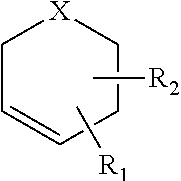Pigmented polymerizable compositions and optical articles prepared therefrom
a polymerizable composition and pigment technology, applied in the field of polymerizable compositions, can solve problems such as light transmission drop
- Summary
- Abstract
- Description
- Claims
- Application Information
AI Technical Summary
Benefits of technology
Problems solved by technology
Method used
Image
Examples
examples
Part 1: Preparation of Pigment Dispersions
[0086]Examples 1, 2 and 3 describe the preparation of pigment dispersions having an appropriately small average pigment particle size for use in an optical product having acceptable transmission and light scattering.
[0087]Commercially available pigments were milled and dispersed in the mill base formula described in the following Table 1 in a two-step process. Pre-dispersion was first accomplished using a basket mill, followed by final dispersion using an EMI Mini Mill from Engineered Mills, Inc. The final dispersion utilized 0.2-0.3 mm YTZ media, the dispersions were milled for the residence times indicated at the bottom of Table 1. The properties of the milled dispersions are given in Table 2.
TABLE 1Pigment Dispersion CompositionsAmount (kg)Mill Base IngredientExample 1Example 2Example 3SOLSPERSE ® 3250010.917.501.34N-Butyl Acetate Urethane Grade——0.11UltraMarine Violet0.49——Premiere PVX 61112PERRINDO ® Violet 293——0.28Tungsten Oxide WO2.7...
PUM
| Property | Measurement | Unit |
|---|---|---|
| particle size | aaaaa | aaaaa |
| particle size | aaaaa | aaaaa |
| particle size | aaaaa | aaaaa |
Abstract
Description
Claims
Application Information
 Login to View More
Login to View More - R&D
- Intellectual Property
- Life Sciences
- Materials
- Tech Scout
- Unparalleled Data Quality
- Higher Quality Content
- 60% Fewer Hallucinations
Browse by: Latest US Patents, China's latest patents, Technical Efficacy Thesaurus, Application Domain, Technology Topic, Popular Technical Reports.
© 2025 PatSnap. All rights reserved.Legal|Privacy policy|Modern Slavery Act Transparency Statement|Sitemap|About US| Contact US: help@patsnap.com



